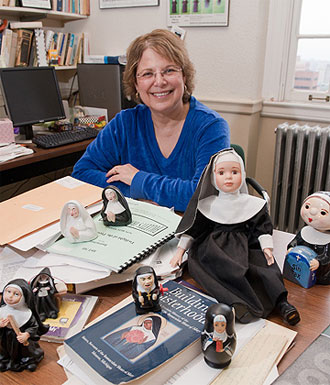Maxwell Perspective: Utter Nunsense
July 7, 2012
From Maxwell Perspective...
Utter Nunsense

Margaret “Peggy” Thompson and some of the nun paraphernalia she’s collected while researching the societal impact of Catholic sisters
According to historian Margaret Thompson, the caricatures of Catholic sisters found in popular culture bear no resemblance to the real-life contributions of nuns.
It all began over lunch with a colleague. “You should do a lecture about nuns in your women’s history class,” the colleague suggested to Margaret “Peggy” Thompson.
Thompson didn’t know much about nuns beyond the images she had gathered from popular culture — the funny outfit, Sally Field as The Flying Nun.
As a good academic, she went to Bird Library and checked out Women’s Religious Orders in the United States, a huge book published in 1930 that she spent the entire weekend reading. “It was very flowery and pious, but the information was astounding,” says Thompson. It seeded Thompson’s chief research interest.
Despite popular imagery that portrays sisters as either “fantastic or ridiculous,” Thompson says the reality is that Catholic sisters were among the first American feminists. Their contributions include serving as battlefield medics in the Civil War, creating parochial schools, running hospitals, marching with Martin Luther King Jr., and leading the modern-day fight against capital punishment. “Many of their institutions — their academies, hospitals, colleges, etc. — were incorporated,” she says, “so they were really the first large group of female corporate executives in America.”
Today, Thompson is considered a leading expert on the history of Catholic sisters and nuns in the United States, a history she considers “one of the great untold stories in American history.”
She’s doing her best to change that. Last year, Thompson recorded an 18-lecture series titled The History of Women Religious in the United States, produced and distributed by Now You Know Media. She is featured in a new documentary film, A Question of Habit, which explores pop-culture fascination with nun imagery. And next year she will publish The Yoke of Grace: American Nuns and Social Change, a history of Catholic sisters in America from the first Ursuline nuns who came to New Orleans in 1727 to the codification of Canon Law in 1917 (which she describes as “both an affirmation of what [nuns] were doing and a way of putting them under control”).
“The archives of American sisters’ communities are one of the great untapped resources of women’s history.”
-Margaret Thompson
Thompson is a professor of history, also with appointments in the departments of religion, political science, and women and gender studies, fields that all come into play in her research. “If you’re looking at straightforward history texts — even if you’re looking at histories of the Catholic Church in the United States — most of them are told through the stories of bishops and priests,” she says. “It’s a very patriarchal church and its story has been told largely through the men.
“The archives of American sisters’ communities,” she adds, “are one of the great untapped resources of women’s history.” Thompson has conducted extensive research at the religious orders themselves, often the first historian outside their community to do so.
“The more communities I went to, the more patterns I found,” she says. “Their influence, not just on the development of Catholicism but on the social history of the United States, was really profound.”
The contributions of sisters in the U.S. include building more than 800 hospitals — among them, the eventual Mayo Clinic — and 10,000 schools, an educational legacy that continues today.
“Women who go to all-women secondary schools and colleges are far more likely to become successful professionals, because they typically have female role models,” says Thompson. “Most such schools are run by nuns.”
Yet most people’s images of nuns run toward inaccurate stereotypes: impossibly saint-like (picture Ingrid Bergman in The Bells of St. Mary’s); comedically daft (a sweet naif in a funny hat); or threatening and repressed (the iron fist of the parochial school classroom). Thompson does her utmost to combat such images.
“Most people are not aware that throughout history, sisters were highly educated and professionally influential,” she says. “Their contributions are immense and transcend a purely religious impact.”